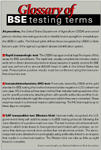Profession responds to second BSE incident
Washington —As the nation shakes off a second case of mad cow, the veterinary profession relies on consumer reaction and government analysis to determine the finding' significance.
WASHINGTON —As the nation shakes off a second case of mad cow, the veterinary profession relies on consumer reaction and government analysis to determine the finding's significance.
The United States Department of Agriculture's (USDA) report of a new bovine spongiform encephalopathy (BSE) case is described as a 12-year-old downer cow from a pet food facility in Waco, Texas. Although this marks the first U.S.-born cow to suffer from the brain-wasting illness, its detection is evidence that "the system has worked," says Dr. Gatz Riddell, executive vice president of the American Association of Bovine Practitioners.
For starters, he says, the cow was born before the 1997 ban on ruminant-to-ruminant feed, a government linchpin to stopping the spread of BSE. Recognized as a downer in November, the animal did not enter the food chain, he says.

Glossary of BSE testing terms
"Spontaneous occurrence" also should be considered, as well as the likelihood of incidence within the nation's cattle herd, which consists of approximately 96 million animals, Riddell adds.
"From our perspective and according to all the experts, having another case or even a small number show up is not unexpected considering the depth of the cattle industry," he says. "We're comfortable that the food supply is safe due to the controls that have been in place."
Little fallout predicted
Consumers seem almost as confident. At presstime, cattle futures already had rebounded from a dip following the United States Department of Agriculture's June 24 announcement confirming the mad cow case.
Despite investors' seemingly calm reaction, some overseas markets proved shakier. As of June 30, Indonesia and Taiwan were the only countries to immediately ban U.S. beef. In Japan, formerly the United State's largest beef importer, the nation's trade doors remained closed. The mad cow report also has fueled fresh safety concerns in South Korea, where officials postponed a meeting to negotiate lifting its 2003 ban on U.S. beef.
"We've worked very hard to reopen export markets; most trading partners have been positive," says Joe Schuele, spokesman for the National Cattlemen's Beef Association (NCBA). "As for consumer confidence, we'll have to wait and see on that. I really don't think because of all the educational efforts that have gone on that it will have a significant impact on the economy. I'm certain there will be some downturn in the market but like the last instance, it will likely be short lived."
Seeking consistency
Schuele's reference is to December 2003 when a Washington dairy cow was identified when USDA detected the case using the sensitive Western blot test.
But since then, federal officials have employed a rapid screen test followed by immunohistochemistry, or IHC, test, which returned a false-negative reading in the second BSE case. Despite the result, USDA's Office of the Inspector General (OIG) recommended further analysis on the brain tissue using the internationally recognized Western blot test and sent samples from the animal to a British laboratory for review.
The resulting positive test reading has prompted NCBA officials to question USDA's reason for ordering the more sophisticated follow-up and demand a "full explanation" from the OIG. The agency since has announced plans to add the Western blot to its testing practices.
"We're still searching for some fact as to why the department decided to break from its protocol on testing," Schuele says. "Our concern wasn't that we preferred one test or another, but having a testing program the producers can have confidence in."